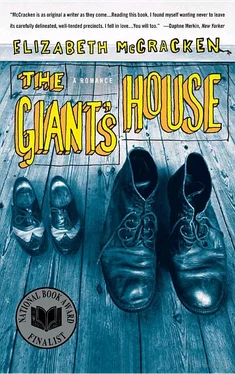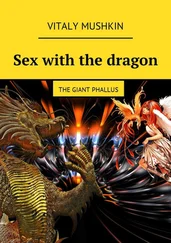“When what?” I said, but I thought, Stella . Maybe that was wrong. Maybe he’d been a little in love with Patty Flood and couldn’t figure out whether her wanting to save his soul was personal or not. If he’d asked me, I would have said, it’s always personal .
He shook his head, smiling sadly. He was like me. He had no vocabulary to even talk about these things.
He bit his lip and said, “I have to protect my heart, Peggy.”
Once upon a time he’d listened to love songs, even if now he’d sworn them off. I’d heard his radio, seen his records, though now I couldn’t find any evidence of that teenage music in the cottage. Only those Jesus singers sung there now, loving God and thinking not too much of man- and womankind. He’d gotten rid of Pat Boone and Dean Martin and the Platters and one particularly deplorable but lovely Elvis Presley record, a gift from Stella. I was worried that it would take a turn, that he’d reverse his early decision and start to believe in God, become religious, think that faith could fill his empty hours. Probably it could. But he didn’t, and in fact the reason he liked the Jesus singers was because they were broken up over an emotion that wasn’t familiar to him and took no energy to receive.
Maybe some nights he craved a brokenhearted singer the way another man might crave whiskey. Maybe those nights he got all the way to the radio, had his hand on the dial before he stopped himself. Slow down, man. One love song and you’ll do nothing but listen to love songs. One love song, and you’re around the bend. And then he’d drop Molly O’Day on the record player again and listen to her explain, carefully, that God tested us every day and every day most of us failed.
His Heart Shares in His Proportions
I want to tell you about his body.
I want to describe his feet, now (he was eighteen) size thirty-seven, triple A. The store in Hyannis still made his shoes. I’d had to call and ask them to rush and make a new pair to replace the old ones, and they told me how to measure everything, instep, width, length. Now I did it regularly. We set his foot down on paper — not typing paper, which was too small, but some stuff cut from a roll at an artists’ supply shop, and traced. I did this. His feet left damp marks on the paper; his second toes were longer than his big toes, and I wondered whether this was a sign of something, either in medicine or folk wisdom.
His calves were unmuscled things. I know because I held on to them while I traced. This was late in the day, eight-thirty or so — we wanted to get his feet at their highest swollen ebb — and I’d slipped my hands up under his pant cuff to hold on.
His thighs—
I want to say that they were like railroad ties, and they were, they were solid and blocky and no wider at the hip than at the knee, but I promised myself I wouldn’t turn his body into something it wasn’t, I wouldn’t compare it to other things. People always did that. They made him into a redwood tree, a building, the Eiffel Tower. I’d never thought about it before, but now suddenly, with so many strangers around, so many new people making guesses, assessing his girth, arm span, I couldn’t help doing it myself. I vowed to stop.
I don’t want to leave you with a man assembled out of household goods, a scarecrow with hands big as toasters and arms long as brooms and glasses the size of a child’s bicycle. I want to detail only facts. For instance, his neck was fifteen and a half inches long, thighs three feet — but that’s how you describe the Statue of Liberty, Mount Rushmore, and it means that his body is getting away from itself again.
I want to say, his body was just a man’s body, only bigger. His thighs were the thighs you have met before in your life, but longer. It was any body you’ve ever known; there was just more of it .
There’s a limit to what I knew then. Oscar gave him sponge baths all his life. I knew his feet best, from measuring and from cutting his toenails. They were my inheritance, my territory. Mine to wash and to diagnose. Every evening I asked him to take off his shoes and socks so I could look for all the danger signs that the doctor had told me about.
One late night, in my apartment, I looked at my own feet. My toenails needed cutting. How did they grow so fast, I wondered. My big toes were calloused, turning in; the nails of my little toes small scabs. All blank, unlike Patty Flood’s blood red bouquet. They were the feet of someone who paid no attention; the feet of a woman who knew that no one would ever be there, at the end of the day, to watch shoes get kicked off, stockings pulled free. The feet of someone responsible for her own weariness. Still, I was tired, and I did not even think about going to the bathroom to take care of matters: I took care of James’s feet, not my own.
It was a doctor — the one from the Midwest, the one who specialized in giantism — who soured me forever on James’s measurements and statistics. Caroline and I did not think James should agree to a visit from him. The article he sent, ripped from the pages of a medical journal, could scare anybody. It was illustrated with photographs of a tall naked man standing next to a short clothed one. The point was that this was a circus giant who claimed to be eight foot two but barely cleared six foot seven; the photographs had been taken by a man who wanted to prove the claim. The doctor exposed him as a fraud; he discussed all the ways a tall man can make himself look taller, the tricks of photography and posture.
The circus giant was skinny, smiling, clearly used to posing for photographs. His hipbones cast shadows over his private parts; all you could see were some vague oval shapes. His nakedness seemed terrible to me, as if it were a demeaning costume he’d agreed to wear in hopes that his personal dignity would compensate.
James wanted the doctor to come. “A specialist,” he said. “That means something.” James had seen specialists in Boston, but they were gland and bone experts; they were as startled by his height as anyone. This new doctor, whose name was Calloway — surely he’d seen it all. Surely our James would just be another note in his life’s work. I didn’t like the tone of the letter. “I have read you are eight feet tall,” he wrote, and you could tell he didn’t believe it.
“Let him come!” said Oscar. “He won’t be disappointed, that’s for sure.”
James read the clipped article over and over again, looking for hope and information. I could have told him, having read the damn thing only once: all the doctor had done was measure the nameless circus giant, that’s all. A carpenter could have written it.
So James invited the doctor, who telephoned, and said that James would have to wait five months, he was terribly sorry but he could not get away, would that be all right?
“By then I’ll be even taller,” James said into the phone. “Yes, still growing.”
Meantime we were getting letters from circuses. Small and big, they all wanted him to hire on, but it was Barnum and Bailey who offered the most, of course — private cars on trains, unbelievable fees. They called. They sent free tickets. One day a man in a dungaree suit showed up at the cottage.
“My outfit’s playing Providence,” he said. “Come down and see. Nice folks. We’ll treat you right.”
Though James liked the man, who acted nonchalant about James’s height and discussed another giant he had known—“Short guy compared to you, only seven-five”—he declined the offer.
James still wanted to visit New York, still did not know that the shoe store wasn’t interested. Maybe he would never have to find out — I thought we could talk Barnum and Bailey into a one-visit contract. James could go up in a hired train car, he could see New York, he could earn a little money for college. We were still talking college in those days. I explained my plan.
Читать дальше












